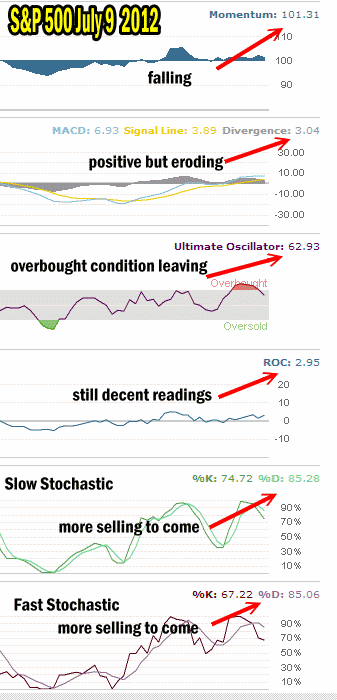Market direction took a hit on Friday with the release of the employment numbers. While 88,000 did not match the expectations of 100,000, I do believe even if the number was at 100,000 the market direction would have softened as the stock market was already over extended and sitting in overbought territory. If you look at the market timing tool the Ultimate Oscillator in the market timing chart below you can see the extreme overbought condition. The employment numbers would have had to surprise very much on the upside for the market direction to have climbed on Friday.
That said, the downturn of the stock market direction has hurt some of the market timing technical indicators which should lead to continued weakness in market direction.
Market Timing Technical Indicators
Momentum is still positive but did decline today. MACD or Moving Average Convergence / Divergence is still positive but two trading sessions ago it was flashing 4.98 divergence while today is has declined to 3.04. Still though it is positive and shows there is strength in the stock market.
The ultimate oscillator has left the overbought condition and it falling back. This could help support the stock market here.
The market timer, Rate of Change is among the most interesting of market timing tools over the past 3 trading sessions. Today’s reading is almost as high as two trading sessions ago and a clear sign that presently rate of change does not see a lot of downside to the overall market direction.
Slow stochastic and fast stochastic are both showing that the selling should continue. The fast stochastic is showing selling over the next couple of trading sessions while the slow stochastic is showing weakness in the market direction for what looks like most of the week.

The general consensus of the market timing indicators is that market direction should continue lower but primarily sideways.
Market Direction is a Range Bound Market
In general the market timing technical tools are showing that the S&P market direction is range bound. But range bound stock markets are excellent for option selling. Put selling in particular as well as selling naked calls can be highly profitable. If the market direction had moved higher then stocks would have been overvalued again which would have meant put selling at overvalued prices. This is something I prefer not to do as it increases the risk of assignment of shares at overvalued stock prices.
An unattractive alternative in an overvalued stock market is put selling further out of the money put option strikes, to try to stay away from overvalued prices, but this makes for small premiums on option selling. As well a rising market makes selling naked calls difficult as a rising market can push higher than most investors anticipate and often this means buying stock to cover naked calls when the naked calls fall into the money. Then after buying the stock to turn the naked calls into covered calls, the market direction changes back to down and the investor ends up holding shares at higher prices and watches as their recently bought stock fall in value.
Market Direction Downside Is Limited
The best thing about put selling is that I am picking the put strikes I am most interested in holding shares at because I know I can sell covered calls to earn more income if assigned shares. So right now the downside is probably limited to around 1300 on the S&P while the upside market direction will stall out near 1400.
Downside Market Direction Pressure
The market can go sideways for some time yet before finally making a decision to move either up or down, but the longer the market is sideways the pressure will grow for the market direction to shift to down to not just build support but test it before rallying back up.
It is always easiest for a market to fall than to rise and sideways markets are notorious for eventually taking the market direction path that is the easiest. But the strength in Monday’s market to recover from the day’s lows is encouraging. If the market can hold and grind slowly higher there is a chance to retest 1400 to see how much resistance there is at that level. But lack of conviction among investors interested in buying stock at prices higher than today’s prices is helping to keep stocks under pressure and as explained, market direction almost always will eventually take the path of least resistance.
